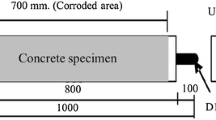Abstract
A good bond between old and new concrete is necessary for a successful repair of concrete structures. The bond is usually determined through pure tension tests,e.g., the common pull off test. However, in most applications, the shear bond strength is more interested. A test apparatus for torsion tests has been developed. Laboratory and field tests have been carried out on cast in place concrete and shotcrete repairs. For waterjetted surfaces, the obtained shear bond strength exceeds 3 MPa,i.e., considerably more than the tensile bond strength which usually varies between 1 and 2 MPa. The shear bond strength is also markedly higher than design strength values found in international codes.
Résumé
Une bonne adhérence entre l'ancien béton et le nouveau est nécessaire à la réussite de la réparation des structures en béton. L'adhérence est habituellement déterminée à partir d'essais en traction pure, comme par exemple un essai classique d'adhérence. Cependant, pour la plupart des applications, la résistance au cisaillement de l'adhérence est un problème plus pertinent. Un équipement pour des essais de torsion a été développé. Des tests en laboratoire et sur site, concernant du béton coulé sur place et du béton projeté, ont été menés. Pour les surfaces traitées par hydrodémolition, la résistance au cisaillement de l'adhérence dépasse 3 MPa, ce qui est largement supérieur à la résistance à la traction, qui varie habituellement entre 1 et 2 MPa. Ainsi, la résistance au cisaillement de l'adhérence est sensiblement plus élevée que les valeurs préconsisées par les codes internationaux.
Similar content being viewed by others
References
Silfwerbrand, J., ‘Improving concrete bond in repaired bridge decks’,Concrete International 12 (9) (1990) 61–66.
Silfwerbrand, J. and Paulsson, J., ‘The Swedish experience: better bonding of bridge deck overlays’,Concrete International 20 (10) (1998) 56–61.
Strömdahl, C., ‘The history of hydrodemolition’,Concrete Engineering International 4 (8) (2000) 32–36.
Swedish National Road Administration, ‘BRO 94. Regulations for Bridges’, Part 7, ‘Bridge Maintenance’, (Borlänge, Sweden, 1994) 47 pp. (Only available in Swedish).
Silfwerbrand, J., ‘Effects of differential shrinkage, creep, and properties of the contact surface on the strength of composite concrete slabs of old and new concrete’. Bulletin No. 147. (Dept. of Structural Mechanics and Engineering, Royal Institute of Technology, Stockholm, Sweden, 1987), 131 pp. (Only available in Swedish).
JOnasson, J.-E., ‘Computer programs for non-linear analyses of concrete in the view of shrinkage, creep and temperature’. Research report No. 7∶77. (Swedish Cement and Concrete Research Institute, Stockholm, Sweden, 1977) 161p. (Only available in Swedish).
Bernard, O., ‘Comportement à long terme des éléments de structure formés de bétons d'âges différents’, Thesis No. 2283 (Department of Civil Engineering, EPFL, Lausanne, Switzerland, 2000) 189p.
Silfwerbrand, J., ‘Stresses and strains in composite concrete beams subjected to differential shrinkage’,ACI Structural Journal 94 (4) (1997) 347–353.
Silfwerbrand, J., ‘Concrete overlays’. Report No. 10, 3rd Edition 10. (Chair of Structural Mechanics and Engineering, Dept. of Structural Engineering, Royal Institute of Technology, Stockholm, Sweden, 1997) 65p. (Only available in Swedish).
Fédération Internationale de la Précontrainte ‘Shear at the interface of precast and in-situ concrete’. Guide to good practice. (Wexham Springs, Slough, 1982). 31 pp.
Delatte, N.J., Wade, D.M. and Fowler, D.W., ‘Laboratory and field testing of concrete bond for expedited bonded concrete overlays’,ACI Materials Journal 97 (3) (2000) 272–280.
Tschegg, E.K., Ingruber, M., Surberg, C.H. and Münger, F., ‘Factors influencing fracture behavior of old-new concrete bonds’,ACI Materials Journal 97 (4) (2000) 447–453.
Silfwerbrand, J., ‘Theoretical and experimental study of strength and behaviour of repaired concrete bridge decks summary’. Bulletin No. 149. (Dept. of Structural Mechanics and Engineering, Royal Institute of Technology, Stockholm, Sweden, 1987) 16p.
Silfwerbrand, J., ‘Concrete repair with shotcrete. Tests on beams under static and fatigue load’. Bulletin No. 153. (Dept. of Structural Mechanics and Engineering, Royal Institute of Technology, Stockholm, Sweden, 1988) 77p. (Only available in Swedish).
Silfwerbrand, J., ‘Concrete repair with shotcrete’ in ‘Durability of Structures’, Proceedings of the IABSE Symposium, Lisbon, September 1989, 785–790.
Swedish National Board of Housing, Building and Planning and AB Svensk Byggtjänst, ‘BBK 94. Concrete structures, part 1— structural design’. Handbook. (Karlskrona and Stockholm, Sweden, 1994) 185p. (Only available in Swedish).
American Concrete Institute, ‘ACI 318 (1999). Building code requirements for structural concrete (ACI 318-99) and commentary (ACI 318R-99)’ (Farmington Hills, Michigan, USA, 1999) 391p.
Comité Euro-International du Béton et Fédération Internationale de la Précontrainte, ‘CEB-FIP Model Code 1990’ (Thomas Telford Services Ltd, London, 1993). 437 p.
European Committee for Standardization, ‘Eurocode 2. Design of Concrete Structures’, 2nd draft. (Brussels, Belgium, January 2001).
Author information
Authors and Affiliations
Additional information
Editorial note Prof. J. Silfwerbrand is a RILEM Senior Member. He is the Director of the Swedish Cement and Concrete Research Institute, a RILEM Titular Member.
Rights and permissions
About this article
Cite this article
Silfwerbrand, J. Shear bond strength in repaired concrete structures. Mat. Struct. 36, 419–424 (2003). https://doi.org/10.1007/BF02481068
Received:
Accepted:
Issue Date:
DOI: https://doi.org/10.1007/BF02481068




